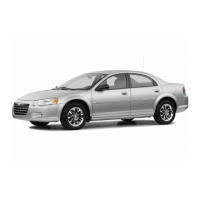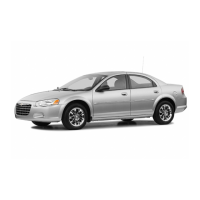HEAT SHIELDS
DESCRIPTION
The catalytic converters have an integral heat
shield attached to them and are not to be removed.
OPERATION
Heat shields are needed to protect both the car and
the environment from the high temperatures devel-
oped in the vicinity of the catalytic converters.
CAUTION: Avoid application of rust prevention
compounds or undercoating materials to exhaust
system heat shields on cars if equipped. Light over
spray near the edges is permitted. Application of
coating will greatly reduce the efficiency of the heat
shields resulting in excessive floor pan tempera-
tures and objectionable fumes.
DIAGNOSIS AND TESTING
EXHAUST SYSTEM
CONDITION POSSIBLE CAUSES CORRECTION
EXCESSIVE EXHAUST NOISE
(UNDER HOOD)
1. Exhaust manifold cracked or
broken.
1. Replace manifold.
2. Manifold to cylinder head leak. 2. Tighten manifold and/or replace
gasket.
3. EGR tube to manifold gasket
leakage.
3. Tighten fasteners or replace
gasket.
4. EGR Valve to EGR tube gasket
leakage.
4. Tighten fasteners or replace
gasket.
5. Exhaust to manifold leak. 5. Tighten or replace V-Band Clamp.
6. Pipe and shell noise from front
exhaust pipe.
6. Characteristic of single wall pipe.
EXCESSIVE EXHAUST NOISE 1. Leak at exhaust pipe joints. 1. Tighten clamps at leaking joints.
2. Burned or rusted out muffler
assembly or exhaust pipe.
2. Replace exhaust module, rear
resonator/tailpipe assembly or
exhaust pipe with catalytic converter
assembly.
3. Burned or rusted out
resonator(s).
3. Replace resonator assembly.
4. Restriction in exhaust system. 4. Remove restriction if possible, or
replace components as necessary.
5. Converter material in muffler or
resonators.
5. Replace muffler, resonators and
converter assemblies. Check fuel
injection and ignition systems for
proper operation.
LH EXHAUST SYSTEM 11 - 3
DESCRIPTION AND OPERATION (Continued)

